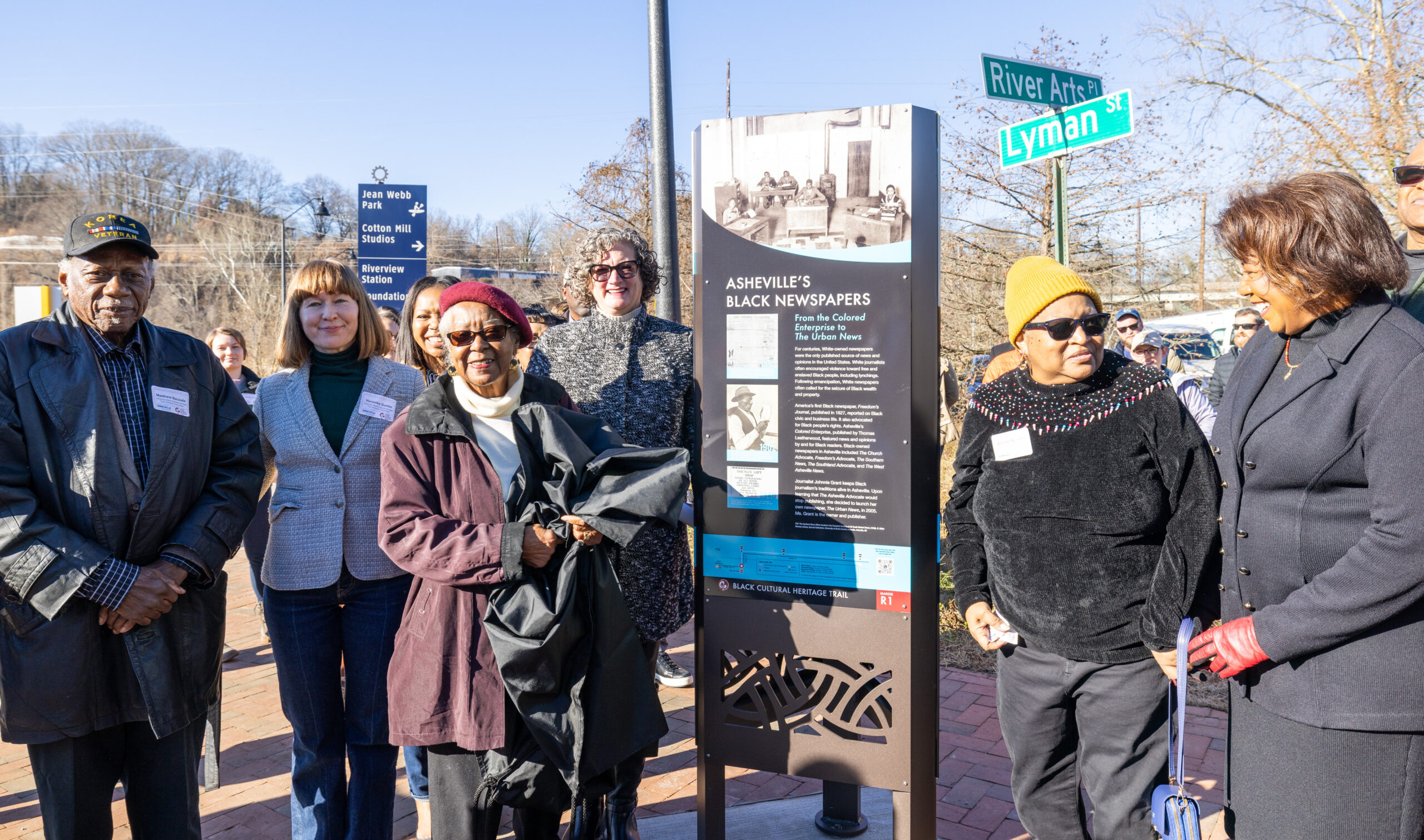
New Interpretive Trail Marks the Resilience of Asheville’s Black Community
Community leaders, government officials, and advocates gathered today at Black Wall Street to witness the unveiling of the Asheville Black Cultural Heritage Trail, marking the culmination of years of extensive community efforts. This trail celebrates the dignity, humanity, and agency of Black people from all backgrounds who built resilient communities and fostered social change in Asheville. During the ceremony, distinguished community members emphasized the importance of sharing stories that pay homage to the rich cultural heritage of Black Asheville.
“Our goal was focused on lifting up Black history in an inclusive way by illuminating stories of resilience and resourcefulness,” said Catherine Mitchell of River Front Development Group. “From aspiration by the East End / Valley Street Neighborhood Association to inspiration by River Front Development Group, in partnership with Explore Asheville and the Buncombe County Tourism Development Authority, we’ve brought together a shared appreciation of some of the hidden lives and stories of Blacks in Asheville. Through the guidance of the Black Cultural Heritage Trail Advisory Committee, we selected stories of bondage, resistance, advocacy, medical care, and entrepreneurship. The trail’s completion represents a moment of celebration, unity, and remembrance.”
Stewarded by the River Front Development Group, an engaged community advisory group, and Explore Asheville staff, the Asheville Black Cultural Heritage Trail shares lesser-told stories of Black Ashevillians. The self-guided interpretive trail comprises 14 stops and 20 panels, spread across three historically significant Black neighborhoods – Downtown, Southside, and the River Area, also known as the River Arts District. Designed to be experienced in sections, the trail is marked by a Sankofa bird logo, encouraging trail-goers to take lessons from the past to build a brighter future. The Asheville Black Cultural Heritage Trail was made possible through a $500,000 Tourism Product Development Fund (TPDF) investment in 2018.
“Asheville‘s Black Cultural Heritage Trail will finally tell the stories of our unsung heroes and under-recognized achievements and contributions of the Black community in the past as well as well-known landmarks in the community today so that Black communities, students, and visitors can answer the question you often hear: ‘Where are the Black people,’“ said Commissioner Al Whitesides of Buncombe County.
The trail offers a blend of in-person and virtual exploration through the digital trail website and app. These platforms provide residents and visitors with additional narratives and multimedia features, including video, oral histories, historical photos, first-person narratives, and news stories. Special features available solely on the digital trail include panel narration by local performer Stephanie Hickling Beckman, a video of local musician Leeda “Lyric” Jones performing the Swannanoa Tunnel Song, and a recorded conversation on finding community and refuge in Hopkins Chapel AME Zion Church. App users can also step into the past with an augmented reality experience at the YMI Cultural Center.
“There are hundreds of fingerprints on this project that shine a spotlight on memories of tears and triumph, darkness and light, struggles and success, reckoning and resilience,” said Vic Isley, President & CEO of Explore Asheville and the Buncombe County Tourism Development Authority. “The Tourism Development Authority holds immense gratitude for the many individuals who contributed to this effort. Thank you for helping document a challenging, complex, and painful past for the possibility of a better and brighter future.”
The Asheville Black Cultural Heritage Trail is now open to the public, inviting residents and visitors to walk through history, reflect on the resilience of Black communities, and gain profound insight into how their contributions have shaped Asheville and Buncombe County.
Highlights of the Asheville Black Cultural Trail Include:
Stephens-Lee High School Educates Legends and Heroes – From 1923 to 1965, Stephens-Lee High School was a nationally recognized Black institution serving five Western N.C. counties. During the Civil Rights Movement, pupils at Stephens-Lee and the Allen School (est. 1887) created the Asheville Student Committee on Racial Equality (ASCORE), which used sit-ins and petitions to help integrate Asheville.
The YMI & William and Georgia Roland – The Young Men’s Institute, now called the YMI Cultural Center, is one of the oldest Black cultural centers in the country. Founded in 1892, YMI offered space for community initiatives such as kindergarten classes, doctors’ offices, and a public library for Black people. William Ernest Roland and Georgia Evelyn Harling, who owned a jewelry store across the street, provided strategy, training, and meeting space to Black teenagers during the Civil Rights Movement.
The National Housing Act of 1934 – The National Housing Act of 1934 was a New Deal program that created low-cost home loans for White people while undermining Black property values. In Asheville, half of Black resident owned homes were demolished, resulting in the relocation of most Black residents to public housing. Together, Marcell Proctor, whose parents lost their home during urban renewal, and Catherine Mitchell led the River Front Development Group, a nonprofit that advocates for affordable housing and improved living conditions for all people.
E.W. and Annis Pearson – Spanish-American War veteran Edward Walton “E.W.” Pearson and his wife Annis Bradshaw Pearson established a legacy of Black enterprise in Asheville. In the 1910s, the Pearsons developed the Pearson Park subdivision (now the Burton Street neighborhood), the Buncombe County and District Colored Agricultural Fair, and the Royal Giants, Asheville’s first Black semi-professional baseball team.
America’s First Black Union Represents Ashevillians – In 1925, Black rail workers formed The Brotherhood of Sleeping Car Porters and Maids Union, which won its first contract in 1937. From the 1930s to the 1960s, many Asheville Pullman porters became civic leaders boosting Southside neighborhood growth.
William R. “Seabron” Saxon – 75-year-old William R. “Seabron” Saxon refused to give up his seat on a bus from Atlanta to Asheville in 1951, four years before Rosa Parks participated in the Montgomery Bus Boycott. Mr. Saxon filed a $15,000 lawsuit, but the judge sided with the bus company.
Matthew Bacoate, Jr., Integrator and Entrepreneur – Asheville native Matthew Bacoate, Jr., operated the first Black-owned manufacturing companies in Western N.C. in the 1960s and 1970s. He counseled Presidents Nixon and Carter on Black entrepreneurship and helped integrate an Asheville bowling alley and the Asheville Municipal Golf Course. Even in his 90s, Mr. Bacoate remains active in Asheville civic life.
For more information about the Asheville Black Cultural Heritage Trail, please visit BCHT.exploreasheville.com.
Photos from Explore Asheville’s Black Cultural Heritage Trail Ceremony can be found here.
